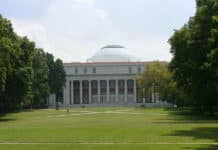One of the world’s oldest and most prestigious colleges, the University of Oxford offers more than 30 halls and colleges where students can learn, live, and flourish.
Today, the English university, which traces its history to the 11th century, has more than 24,000 students, split about evenly between undergraduates and graduates.
Admission is competitive. In three recent admission cycles, Oxford received more than 23,000 applications for about 3,300 available undergraduate spots.
Undergrads and graduate students all belong to a college, which are located across the city of Oxford and serve as a home base during their time at the university.
They eat and live in their respective college, but also mix with students from other Oxford colleges, including in friendly sporting competitions. Colleges generally have the same basic structure, with a dining hall, library, student housing, and spaces for the arts and sports.
Oxford applicants are not required to select a college when they submit their paperwork, but they can indicate their preference. Even so, another college might offer them a place instead.
Below, we’ll take a closer look at Oxford’s 10 best colleges, ranked according to where each school stands in the Norrington Table, an annual ranking of Oxford’s best colleges that rank schools based on their finals performances.
This article and its ranking is based on the 2020 Norrington Table ranking.
Here are the 10 best colleges at Oxford University.
10. Lincoln College

Lincoln College prides itself on being a small, supportive, and close-knit college, admitting approximately 90 undergraduate students annually.
The Junior Common Room has been around since 1854, and today its students can choose from a wide range of math- and science-based majors as well as several arts and history programs.
Lincoln also has a thriving graduate student population of about 300, who can pick from more than 200 graduate courses spread across four divisions of study spanning the arts and sciences. The graduate student body, aka the middle common room, is the oldest of its kind in Oxford.
No matter their level of study, Lincoln students can participate in many traditions and activities. The college has comfortable spaces and living quarters where students can gather to relax or work on their studies.
9. Oriel College

About 300 undergraduate and 250 postgraduate students make up the Oriel College community. Undergrads can choose from a few dozen majors, ranging from the classics and sciences to mathematics and philosophy.
On the postgraduate side, Oriel offers loads of academic focuses and also appoints several students as graduate teaching assistants. The college’s fellows participate in research and often hold talks and other activities graduate students can attend.
Undergrads live in the college throughout their time at Oxford, and Oriel also provides housing for first-year postgraduate students, all of whom can participate in various sports and clubs. Its facilities include not only leisurely spaces like a gym, music room, and bar but also a library that’s open 24/7 and a chapel. Music is at the heart of Oriel, where students can join the college choir or take “masterclasses” from visiting performers.
8. St. John’s College

St. John’s College offers more than two dozen undergraduate majors plus numerous master- and doctoral-level fields of study. The college also touts itself as having some of the most affordable student accommodation at Oxford, with homes available for undergraduates during their entire Oxford career and for first-year graduate students.
Students can grab a meal in the traditional dining hall or cafe, or they can take advantage of the kitchen to whip something up themselves. The college’s sports teams range from the traditional (rowing) to contemporary (ultimate frisbee), and students have opportunities to join musical and dramatic groups, too.
One of the jewels of St. John’s, though, is the recently built, state-of-the-art Library and Study Centre, which physically unites the college’s past and present. The construction project has conserved some of the college’s historical buildings while giving students a modern place to learn.
7. Brasenose College

From prime ministers and poets to economists and codebreakers, Brasenose College is a place full of famous names and infamous legends. Founded in the early 1500s, Brasenose admitted men only until the 1970s. These days, the co-ed college welcomes a diverse group of about 100 undergraduates annually, with 17 courses of study for them to pursue.
Graduate students live in two buildings constructed especially for them close to the school and can enjoy a variety of activities offered through the remarkable Hulme Common Room.
Each summer, Brasenose runs an Arts Festival on the New Quad, where students can gather during the school year. The college also is home to Bar/Gerties, which students describe as “the centre of college life,” and the Smith Reading Room, a great study spot separate from the library.
And when they leave Brasenose, alumni become part of a prestigious group that includes former British Prime Minister David Cameron and “Monty Python” star Michael Palin.
6. Wadham College

Founded in 1610, Wadham College describes itself as a progressive, liberal community of about 450 undergraduates and 250 graduate students.
The college prides itself on embracing not only academic greatness but also diversity. It promotes equality in its various endeavors and even picks three fellows to serve as tutors in topics like race and diversity.
Wadham’s campus features buildings in a mix of architectural styles that house one of the largest halls in the university and Holywell Music Room, which opened in July 1748 and is believed to be Europe’s oldest, purpose-built music room. The library collection includes many historical manuscripts and rare books, and students interested in Persian history will be keen to check out the library’s special collection of 4,500 books on the subject.
The campus also features six gardens that offer a perfect place for students to relax and reflect. And in 2012, Wadham opened the McCall MacBain Graduate Centre, a contemporary facility open to graduate students and some undergraduates.
5. Merton College

One of Oxford’s oldest colleges, Merton College is the place that educated such eminent writers as J.R.R. Tolkien and T.S. Eliot.
Founded in 1264, Merton today welcomes around 90 new undergraduates each year, who can choose their academic focus from more than a dozen subjects. More than half of Merton’s student body consists of graduate students, who can join two organizations, the History of the Book Research Group and the Biomedical and Life Sciences Research Group.
The college, which celebrated its 750th anniversary in 2014, also has the oldest quadrangle at Oxford, the Mob Quadrangle. There, students will find Mob Library, the oldest academic university library in continuous operation in the world. Merton students can also find what they need at the college’s second library, OWL, located in a former Victorian home.
In 2020, Merton marked the 40th anniversary of the admission of the college’s first female students.
4. St. Peter’s College

One of Oxford’s newer colleges, St. Peter’s opened as a hall in 1929 and became a full college in 1961.
More than 400 undergraduate and graduate students now study at St. Peter’s, which describes itself as an inclusive community. The college’s long history of welcoming diversity began with its first class, which included a Black student from Uganda. The emphasis on equality and diversity continues today with the E&D Forum, in which students and staff work together on projects promoting those ideals.
As the college approaches its centennial, it continues to grow. St. Peter’s recently acquired a site where it plans to construct affordable student housing in addition to installing a new courtyard, common room and college entrance. The college plans to celebrate the opening of the Castle Hill House project in the spring of 2023.
3. Queen’s College

Founded in 1341 and Located on Oxford’s High Street, Queen’s College brings in 90 to 100 undergraduate students and around 75 graduate students each year for study in a wide range of subjects.
The college guarantees housing for undergraduates and, when available, offers on-campus space to graduate students, who make up about one-third of the college’s student body.
Students learn among the 18th-century buildings that form the main part of the college, but Queen’s has modern spaces as well, including the New Library, which opened in 2017 under the Provost’s Garden. Or, students can choose to dig into the books at the 17th-century Upper Library and the 19th-century Lower Library.
Queen’s has lots of perks, too, including being a fully catered college, with affordable meals offered at cost to students. They also can gather in the Junior Common Room daily at 4 p.m. for tea, where they can socialize while grabbing a quick bite and a “cuppa.”
2. St. Catherine’s College

St. Catherine’s is both Oxford’s largest and newest college, educating a diverse community since 1962.
Students from more than 50 countries attend classes at the college known as “St. Catz,” including some attending as part of a study abroad program.
The college offers undergraduate and graduate programs, and students interested in theater have an opportunity to learn from theater professionals thanks to an endowed position, the Cameron Mackintosh Visiting Professor of Contemporary Theatre.
St. Catz admits a large number of graduate students each year compared to some of Oxford’s other colleges. More than 400 students hailing from a variety of educational disciplines make up the Middle Common Room, which in 2020 got a new multi-purpose building to enjoy, the Ainsworth Graduate Centre.
Unlike many of Oxford’s colleges, which have a strong religious background, St. Catz’s 20th-century campus does not have a chapel, instead embracing a secular lifestyle. Other notable features of the campus, which sits along the River Cherwell, include a water garden and amphitheater.
1. The New College

New College is quite the misnomer, as the college opened way back in 1379.
Officially named the College of St. Mary of Winchester in Oxford but better known by its nickname, New College educates undergraduates and graduates students. It has a large international population, with a third of its student body coming from 140 countries.
New College has some outstanding architecture, including its recently restored hall with Tudor paneling and a medieval kitchen. Visitors may also recognize the college thanks to its famous Cloisters, where part of the movie “Harry Potter and the Goblet of Fire” filmed.
While New College has a rich history, its future students have a bright future ahead of them. The college plans extensive redevelopment that will allow it to house all of its undergrads in addition to creating flexible learning spaces and an arts venue, among other new features.














